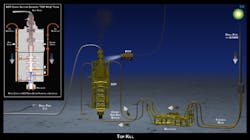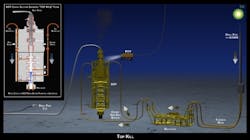BP oil spill: Top kill delayed, patience wears thin
May 24, 2010 -- BP COO Doug Suttles said this morning in a television interview that it will be at least Wednesday before the top kill strategy will be attempted. Originally, BP had hoped to commence the operation yesterday (Sunday), then pushed it to Tuesday. Now, it's been delayed yet again.
The top kill method involves injecting mud and other heavy fluids into the well, followed by concrete, to permanently seal the opening. BP hopes this will stop the flow of oil spewing from the busted BOP and riser. To date, over 6 million gallons of crude oil have been spilled into the waters of the Gulf of Mexico since the Deepwater Horizon rig exploded on April 20, claiming 11 lives.
To add insult to injury, BP rebuffed the EPA's order to reevaluate the company's choice of dispersant. In its response, BP said that based on availability and toxicity ratings it believes Corexit is the right product for this mission and intends to continue using it.
Meanwhile, the U.S. government has been subject to harsh criticism for its seemingly limited involvement in the oil spill response. Interior Secretary Ken Salazar defended the government's response, pointing out that the U.S. has sent 1,000 vessels and more than 20,000 workers to the regions, and has conducted controlled burning and boom deployment operations.
Salazar reaffirmed the federal government's commitment to hold BP accountable for clean up, and said U.S. officials would “keep our boot on their neck until the job gets done.”
He also added that the U.S. will "push them out of the way appropriately" if it's determined that BP isn't doing what it should be doing.
In perhaps a step in that direction, the U.S. government has created the Flow Rate Technical Team (FRTT), which will focus on providing accurate estimates on the amount of oil gushing into the Gulf of Mexico. The team comprises members from the US coast Guard, NOAA, MMS, Department of Energy and the US Geological Survey.
The flow rate of 5,000 barrels (210,000 gallons) per day, quoted since the very early days of the disaster, is hotly disputed by environmentalists and academics who say that, based on video footage released by BP, it is in fact much higher.
So far, BP has spent in the vicinity of $700 million on response efforts. Just this morning, the company announced it will commit an additional $500 million to a research program that will study the impact of the disaster as well as the response effort.
Tony Hayward, BP's chief executive, said this 10-year open research effort "will be a key part of the process of restoration, and for improving the industry response capability for the future."
EPA Administrator Lisa P. Jackson is currently in the affected area, having returned for her third visit to the Gulf Coast since the disaster. She will be monitoring the response efforts and talking with residents about the spill's effect on the region.
The spill has tainted 150 miles of coastline and penetrated more than 12 miles into Louisiana's sensitive wetlands.
Related Articles
BP oil spill: Slick enters Louisiana wetlands, loop current >
BP oil spill: Tar balls found on Keys shoreline not linked to Deepwater Horizon >
BP oil spill: Some oil could enter loop current; Fishery closures in gulf waters to expand >
BP oil spill: Siphon now working, collecting 'some' oil; Concerns turn toward 'loop current' >
BP oil spill: Setback in attempt to siphon oil from gulf waters, engineers will try again >
BP oil spill: Cleanup battle rages on in waters of Gulf of Mexico >
BP oil spill: Update on cleanup of gulf waters, underwater video released>
BP oil spill: Clean up of gulf waters continues >
BP oil spill: Measures to mitigate wetland damage, stem flow ...>
BP oil spill: Clean-up attempt fails, wetlands under grave threat >
###

